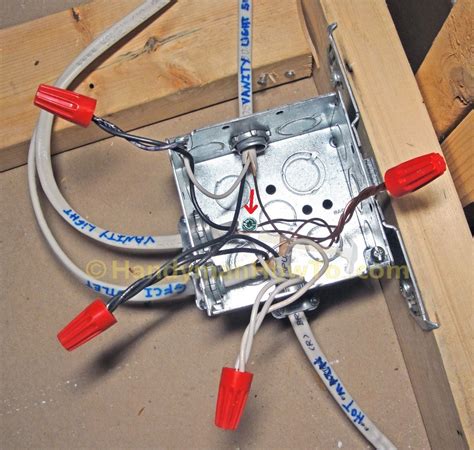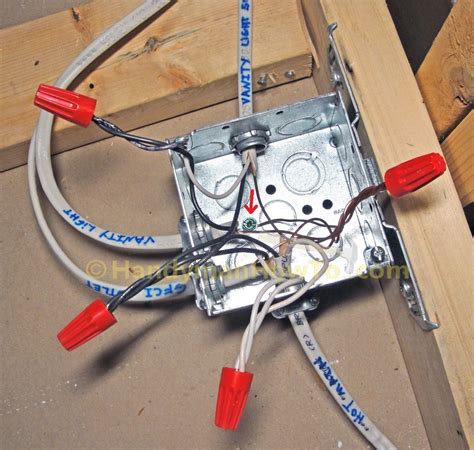connections not in junction boxes Mistake: Not using an electrical box. “Electrical boxes, sometimes referred to as junction boxes, protect connections from accidental damage, and help contain sparks and heat from a loose connection or short circuit,” says . Vintage Disney Cinderella Metal Lunchbox Including Thermos Bottle 1998.Selling as is! Any imperfections are shown in photos. Ask any questions!! At BFindsVintage, we care about leaving the planet bett.from
0 · wiring a junction box diagram
1 · where are junction boxes located
2 · junction box where to use
3 · junction box screwfix
4 · how to mount junction box
5 · electrical wire connector junction box
6 · 40 amp junction box screwfix
7 · 240v junction box wiring
$600.00

wiring a junction box diagram
There's only one product that is supposed to be code approved that can be buried. You are correct, a junction box must be used and must be accessible and covered. Mistake: Not using an electrical box. “Electrical boxes, sometimes referred to as junction boxes, protect connections from accidental damage, and help contain sparks and heat from a loose connection or short circuit,” says . The key difference between a junction box and an outlet is their intended use. A junction box is designed to protect electrical connections, while an outlet is designed to . It is not required, but it can be a good idea. Personally, I would prefer them to be in conduit (e.g. ENT/smurf tube) with splices in junction boxes. Just like with electrical wires, it will protect them from damage while providing .
Plus fixtures (e.g., lights, ceiling fans) often need to be removed to access ceiling junction boxes. But the key is that normal access - e.g., replace a receptacle or switch, patch . Chapter 8 splices do not require a junction box, and splices for things that are outside the NEC, like overhead service conductors and utility work are frequently made in . No that's not true. A junction box is perfectly okay if you can see it or easily access it. The problem is junction boxes used in inaccessible places, like under floorboards, where they will be hidden. So if you are planning on using .
A junction box is not a special type of box but any standard electrical box used to enclose wire splices. The most commonly used box for junctions is a 4-inch square box (either metal or strong plastic), which offers . Loose connections inside a wall can cause unexpected (and unwanted!) problems. Whenever a new switch or outlet is added to a circuit, there may be a new circuit device in an . But some devices do not require a separate junction box. Usually, they have their own integrated boxes or enclosures for making the wire connections. Learn which devices don't need junction boxes, and when to install junction boxes. There's only one product that is supposed to be code approved that can be buried. You are correct, a junction box must be used and must be accessible and covered.
Mistake: Not using an electrical box. “Electrical boxes, sometimes referred to as junction boxes, protect connections from accidental damage, and help contain sparks and heat from a loose connection or short circuit,” says Gerald Talbot, licensed electrician with . The key difference between a junction box and an outlet is their intended use. A junction box is designed to protect electrical connections, while an outlet is designed to provide a connection point for devices. While an outlet may have some internal wiring and connections, it is not designed to serve as a junction box and should not be used as . It is not required, but it can be a good idea. Personally, I would prefer them to be in conduit (e.g. ENT/smurf tube) with splices in junction boxes. Just like with electrical wires, it will protect them from damage while providing accessibility for splices.
Plus fixtures (e.g., lights, ceiling fans) often need to be removed to access ceiling junction boxes. But the key is that normal access - e.g., replace a receptacle or switch, patch in a new cable to a junction box to power something else, etc. - . Chapter 8 splices do not require a junction box, and splices for things that are outside the NEC, like overhead service conductors and utility work are frequently made in open-air, and furthermore are not insulated. Underground splices for cable types like UF also do not require boxes or enclosures.
No that's not true. A junction box is perfectly okay if you can see it or easily access it. The problem is junction boxes used in inaccessible places, like under floorboards, where they will be hidden. So if you are planning on using them in a loft that's not a problem.
A junction box is not a special type of box but any standard electrical box used to enclose wire splices. The most commonly used box for junctions is a 4-inch square box (either metal or strong plastic), which offers ample space for making wire connections with multiple wires or .

Readily accessible means capable of being reached quickly for actions (like operating a switch) without requiring the need to use tools, climb over obstacles, etc. to gain access. It can apply to but is not limited to disconnecting methods. Need help understanding code section 314.29 2017 NEC.
But some devices do not require a separate junction box. Usually, they have their own integrated boxes or enclosures for making the wire connections. Learn which devices don't need junction boxes, and when to install junction boxes. There's only one product that is supposed to be code approved that can be buried. You are correct, a junction box must be used and must be accessible and covered. Mistake: Not using an electrical box. “Electrical boxes, sometimes referred to as junction boxes, protect connections from accidental damage, and help contain sparks and heat from a loose connection or short circuit,” says Gerald Talbot, licensed electrician with . The key difference between a junction box and an outlet is their intended use. A junction box is designed to protect electrical connections, while an outlet is designed to provide a connection point for devices. While an outlet may have some internal wiring and connections, it is not designed to serve as a junction box and should not be used as .
It is not required, but it can be a good idea. Personally, I would prefer them to be in conduit (e.g. ENT/smurf tube) with splices in junction boxes. Just like with electrical wires, it will protect them from damage while providing accessibility for splices.
where are junction boxes located
Plus fixtures (e.g., lights, ceiling fans) often need to be removed to access ceiling junction boxes. But the key is that normal access - e.g., replace a receptacle or switch, patch in a new cable to a junction box to power something else, etc. - . Chapter 8 splices do not require a junction box, and splices for things that are outside the NEC, like overhead service conductors and utility work are frequently made in open-air, and furthermore are not insulated. Underground splices for cable types like UF also do not require boxes or enclosures.
No that's not true. A junction box is perfectly okay if you can see it or easily access it. The problem is junction boxes used in inaccessible places, like under floorboards, where they will be hidden. So if you are planning on using them in a loft that's not a problem. A junction box is not a special type of box but any standard electrical box used to enclose wire splices. The most commonly used box for junctions is a 4-inch square box (either metal or strong plastic), which offers ample space for making wire connections with multiple wires or .

metal adaptable box with din rail
CRAFTSMAN 26" INTERMEDIATE MIDDLE TOOL BOX, 4-DRAWERS, 706.59900. Get the best deal for Craftsman Collectible Tool Boxes & Chests from the largest online selection at eBay.ca. | Browse our daily deals for even more savings! | Free shipping on many items!
connections not in junction boxes|junction box where to use